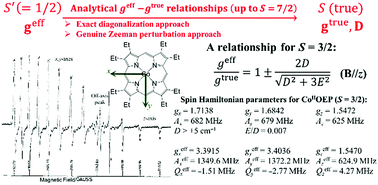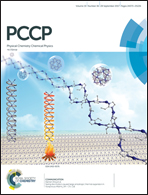Analyses of sizable ZFS and magnetic tensors of high spin metallocomplexes†
Abstract
The fictitious spin-1/2 Hamiltonian approach is the putative method to analyze the fine-structure/hyperfine ESR spectra of high spin metallocomplexes having sizable zerofield splitting (ZFS), thus giving salient principal g-values far from around g = 2 without explicitly providing their ZFS parameters in most cases. Indeed, the significant departure of the g-values from g = 2 is indicative of the occurrence of their high spin states, but naturally they never agree with true g-values acquired by quantum chemical calculations such as sophisticated DFT or ab initio MO calculations. In this work, we propose facile approaches to determine the magnetic tensors of high spin metallocomplexes having sizable ZFS, instead of performing advanced high-field/high-frequency ESR spectroscopy. We have revisited analytical expressions for the relationship between effective g-values and true principal g-values for high spins. The useful analytical formulas for the geff–gtrue relationships are given for S's up to 7/2. The genuine Zeeman perturbation formalism gives the exact solutions for S = 3/2, and for higher S's it is much more accurate than the pseudo-Zeeman perturbation approach documented so far (A. Abragam and B. Bleaney, Electron Paramagnetic Resonance of Transition Metal Ions, 1970; J. R. Pilbrow, J. Magn. Reson., 1978, 31, 479; F. Trandafir et al., Appl. Magn. Reson., 2007, 31, 553; M. Fittipaldi et al., J. Phys. Chem. B, 2008, 112, 3859), in which the E(Sx2 − Sy2) term is putatively treated to the second order. To show the usefulness of the present approach, we exploit FeIII(Cl)OEP (S = 5/2) (OEP: 2,3,7,8,12,13,17,18-octaethylporphyrin) and CoIIOEP (S = 3/2) well magnetically diluted in the diamagnetic host crystal lattice of NiIIOEP. The advantage of single-crystal ESR spectroscopy lies in the fact that the molecular information on the principal axes of the magnetic tensors is crucial in comparing with reliable theoretical results. In high spin states of metallocomplexes with sizable ZFS in pseudo-octahedral symmetry, their fine-structure ESR transitions for the principal z-axis orientation appear in the lower field far from g = 2 at the X-band, disagreeing with the putative intuitive picture obtained using relevant ESR spectroscopy. A ReIII,IV dinuclear complex in a mixed valence state exemplifies the cases, whose fine-structure/hyperfine ESR spectra of the neat crystals have been analyzed in their principal-axis system. The DFT-based/ab initio MO calculations of the magnetic tensors for all the high spin entities in this work were carried out.



 Please wait while we load your content...
Please wait while we load your content...